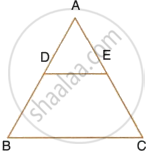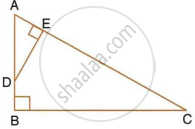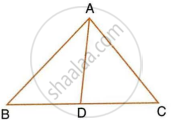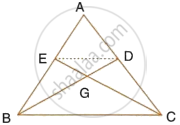Advertisements
Advertisements
Question
In the given figure, ΔABC ~ ΔADE. If AE : EC = 4 : 7 and DE = 6.6 cm, find BC. If 'x' be the length of the perpendicular from A to DE, find the length of perpendicular from A to BC in terms of 'x'.

Solution

ΔABC ∼ ΔADE
AE : EC = 4 : 7, DE = 6.6 cm, BC = ?
Draw AL ⊥ DE and AM ⊥ BC
And AL = x cm
Find AM in terms of x
∵ ΔADE ∼ ΔABC
∴ `(AE)/(AC) = (DE)/(BC)`
∴ `(AE)/(AC) = (AE)/(AE + EC) = 4/(4 + 7) = 4/11`
∴ `(DE)/(BC) = (AE)/(AC) \implies 4/11 = 6.6/(BC)`
`\implies BC = (6.6 xx 11)/4`
= `36.3/2`
= 18.15 cm
∵ AL ⊥ DE and on producing it to BC then AM ⊥ BC
`(AL)/(AM) = (AE)/(AC) \implies x/(AM) = 4/11`
`\implies AM = (11 xx x)/4 = 11/4 x`
APPEARS IN
RELATED QUESTIONS
ABC is a right angled triangle with ∠ABC = 90°. D is any point on AB and DE is perpendicular to AC. Prove that :

- ΔADE ∼ ΔACB.
- If AC = 13 cm, BC = 5 cm and AE = 4 cm. Find DE and AD.
- Find, area of ΔADE : area of quadrilateral BCED.
In ΔABC, ∠ABC = ∠DAC, AB = 8 cm, AC = 4 cm and AD = 5 cm.
- Prove that ΔACD is similar to ΔBCA.
- Find BC and CD.
- Find area of ΔACD : area of ΔABC.

State, true or false:
All equiangular triangles are similar.
In the figure, given below, the medians BD and CE of a triangle ABC meet at G. Prove that:

- ΔEGD ~ ΔCGB and
- BG = 2GD from (i) above.
In an isosceles ΔABC, the base AB is produced both ways in P and Q such that
AP × BQ = AC2.
Prove that ΔACP~ΔBCQ.

In ΔPQR, PQ = 10 cm, QR = 12cm, PR = 8 cm, find the biggest and the smallest angle of the triangle.
The scale of a map is 1 : 200000. A plot of land of area 20km2 is to be represented on the map. Find
The area on the map that represents the plot of land.
The actual area of an island is 1872km2 . On a map, this area is 117 cm2. if the length of the coastline is 44cm on the map, find the length of its actual coastline.
A triangle ABC has been enlarged by scale factor m = 2.5 to the triangle A' B' C'. Calculate : the length of C' A' if CA = 4 cm.
Prove that if a line is drawn parallel to one side of a triangle intersecting the other two sides in distinct points, then the other two sides are divided in the same ratio.
Using the above theorem prove that a line through the point of intersection of the diagonals and parallel to the base of the trapezium divides the non-parallel sides in the same ratio.
